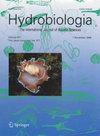墨西哥热带太平洋Carrizales礁Pocillopora珊瑚基因表达可塑性的两个生物标志物
IF 0.3
4区 生物学
Q4 MARINE & FRESHWATER BIOLOGY
引用次数: 0
摘要
背景。基因表达(GE)可塑性是一种适应反应,使生物体能够迅速适应环境变化,提供适应优势。转基因生物标志物正在成为一种有价值的工具,可以将生物体的生理可塑性与大规模气候条件和局部影响(如温度和营养)的协同效应联系起来。目标。在这项研究中,我们研究了70 kda热休克蛋白(hsp70)和碳酸酐酶(CA)的GE可塑性,以确认这两个基因分别作为细胞应激反应和细胞稳态反应的生物标志物的能力。方法。采用qPCR技术,以共生菌科(symbiodiiiaceae)的细胞密度和叶绿素含量为健康指标,评价了墨西哥科利马海岸Carrizales礁(Colima coast)自然暴露于海表温度、生产力和营养物质变化环境下的Pocillopora capitata、Pocillopora damicornis和Pocillopora verrucosa珊瑚群落的GE可塑性。结果。我们的研究结果清楚地表明,疣孢和damicornis Pocillopora hsp70的GE可塑性与温度和营养物质的日常环境变化有关。另一方面,CA基因表达对日变化的响应没有变化。而CA的表达量显著高,hsp70的表达量显著低。此外,我们发现在健康指标上没有显著差异,表明Pocillopora珊瑚具有一定程度的生理可塑性,如其广泛的形态可塑性,可以反映出墨西哥太平洋中部春季对低温和高营养的不同适应能力。结论。评估表型可塑性(形态学和分子生理学)可以帮助鉴定具有更大生存环境压力潜力的珊瑚群落。后者是管理、保护和恢复墨西哥太平洋珊瑚礁的重要考虑因素。本文章由计算机程序翻译,如有差异,请以英文原文为准。
Two biomarkers of gene expression plasticity in Pocillopora corals from the Carrizales reef, Mexican Tropical Pacific
Background. Gene expression (GE) plasticity is an acclimation response that allows organisms to adjust rapidly to environmental changes, providing an adaptive advantage. GE biomarkers are emerging as a valua-ble tool for linking the organism’s physiological plasticitywith the synergetic effects of large-scale climatic conditions and local impacts such as temperature and nutrients. Objectives. In this study, we investigate the GE plasticity of the 70-kDa heat shock protein (hsp70) and the carbonic anhydrase enzyme (CA) to confirm the ability of those two genes as biomarkers of the Cellular Stress Response and Cellular Homeostasis Res-ponse, respectively. Methods. Using qPCR, we evaluate the GE plasticity of coral colonies from Pocillopora capitata, Pocillopora damicornis,and Pocillopora verrucosa at the Carrizales reef (Colima coast of Mexico) naturally exposed to environmental changes in the Sea Surface Temperature (SST), productivity and nutrients using the cellular density of Symbiodiniaceae and chlorophyll content as health indices. Results. Our results clearly show GE plasticity in the hsp70 for Pocillopora verrucosa and Pocillopora damicornis related to a daily environmental change in temperature and nutrients. On the other hand, the CA gene expression shows no change in response to daily variations. However, there was a significantly high expression of CA and a lower expression of hsp70 in Pocillopora capitata. Furthermore, we found no significant differences in the health in-dices, suggesting some degree of physiological plasticity in Pocillopora corals like its extensive morphological plasticity that could reflect different adaptation capacities to low temperatures and high nutrients during the spring season in the central Mexican Pacific. Conclusions. Evaluating the phenotypic plasticity (morphology and molecular physiology) could help identify coral colonies with a more significant potential to survive en-vironmental stressors. The latter is an essential consideration for managing, conserving, and restoring coral reefs in the Mexican Pacific.
求助全文
通过发布文献求助,成功后即可免费获取论文全文。
去求助
来源期刊

Hidrobiologica
生物-海洋与淡水生物学
CiteScore
0.40
自引率
0.00%
发文量
8
审稿时长
>12 weeks
期刊介绍:
HIDROBIOLÓGICA es una publicación cuatrimestral que difunde trabajos originales e inéditos de investigación o revisión, sobre temas relacionados con los organismos y la hidrología de los ambientes acuáticos, dulces y marinos y va dirigida a investigadores de todo el mundo, interesados en las diversas disciplinas que incluye la Hidrobiología , así como a alumnos de posgrados y licenciaturas relacionados con la biología, ecología, taxonomía, filogenia y evolución de organismos acuáticos, e hidrología y oceanografía de ambientes s dulceacuícolas y marinos.
 求助内容:
求助内容: 应助结果提醒方式:
应助结果提醒方式:


